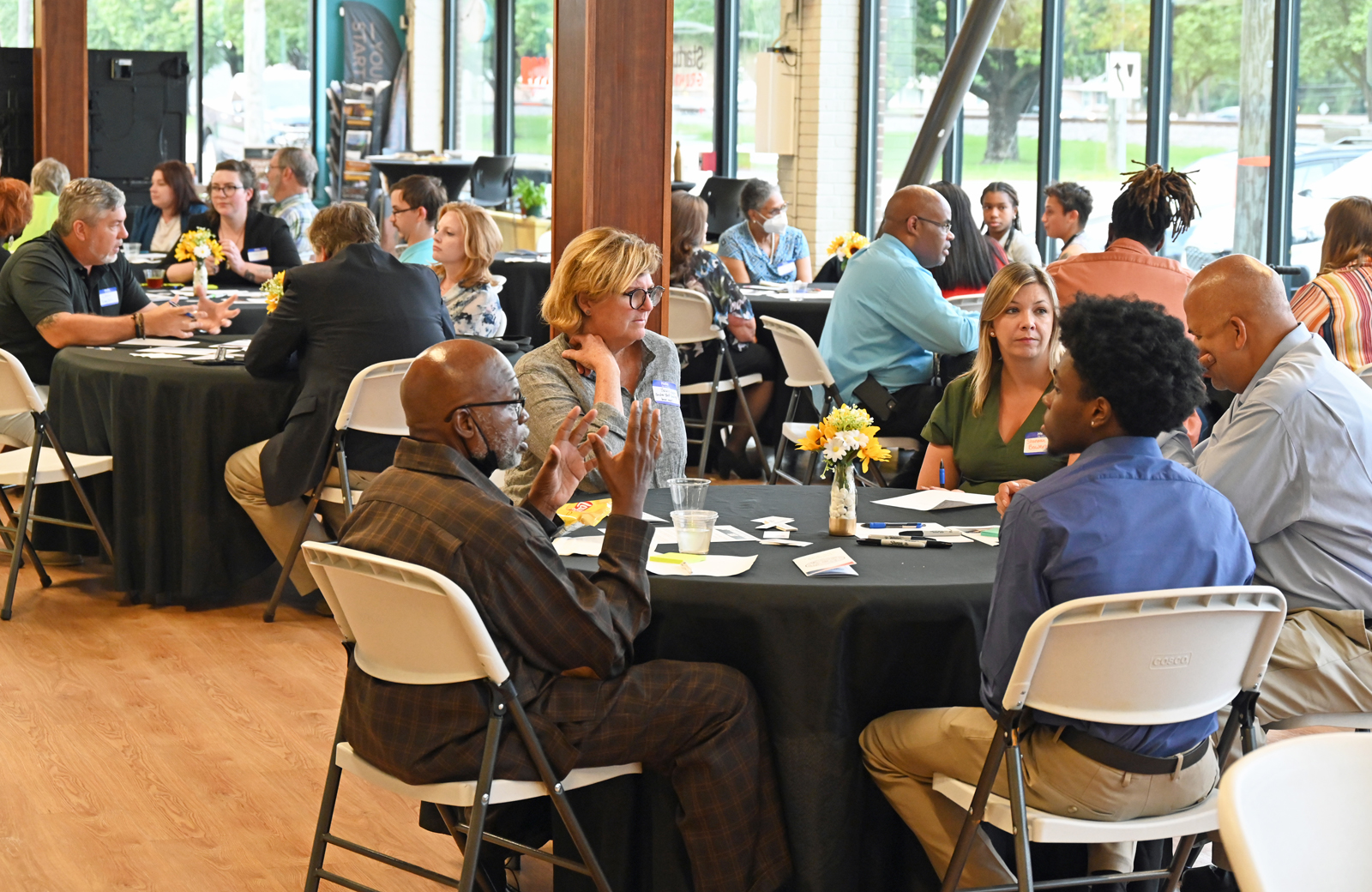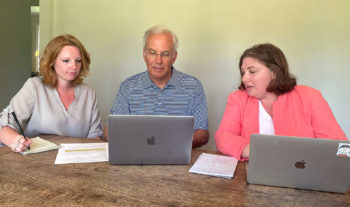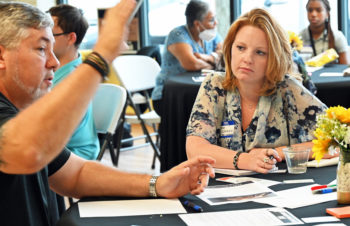How the Border Belt Independent provides deep-dives for North Carolina newsrooms
Les High and Sarah Nagem, Border Belt Independent,
A listening session at UNC-Pembroke brought a diverse audience and a number of suggestions. (Les High/Border Belt Independent)
Here’s an idea to steal and adapt: As a digital news start-up, the Border Belt Independent partners with local newspapers to provide them with long-form stories at no cost. It helps grow our audience and provides them with in-depth reporting their readers expect.This is a series on Better News to a) showcase innovative/experimental ideas that emerge from the Knight-Lenfest Newsroom Initiative and b) share replicable tactics that benefit the news industry as a whole. This “win” comes from Les High, founder and publisher, and Sarah Nagem, editor, both of the Border Belt Independent, which participated in the University of North Carolina Table Stakes program in 2021-2022.
Question: What communities do you serve and what can you tell us about the history of your organization?
Answer: We serve four rural, high-poverty counties in the southeastern corner of North Carolina, most of which lie on the border with South Carolina.
Border Belt Independent Publisher Les High is a third-generation journalist who was a reporter, editor and publisher of The News Reporter, his family’s newspaper in Columbus County.
(Read this 2019 Better News piece about how The News Reporter built a digital-first workflow, established a metered paywall and consolidated its subscription plans.)
The High family sold The News Reporter in August 2021, but Les had been thinking about models that would provide reliable, trusted news in rural regions that had become or could become news deserts. The BBI began publishing in May 2021.
It is a North Carolina nonprofit and is seeking federal 501(c)(3) status. The North Carolina Press Foundation is the BBI’s fiscal sponsor.
Q: What problem were you trying to solve, and why was solving the problem strategically important for your organization?
A: As a new online organization, the BBI started with an audience of zero. Our North Star is “To be known and to be a force for good.” People in the region are generally distrustful of the media and rely on social media like Facebook for their news. It’s hard to be a force for good if no one sees your stories.
Q: How is this approach related to Table Stakes (e.g. one of the 7 Table Stakes and/or an outgrowth of the Knight-Lenfest initiative, etc.)?
A: This initiative is related to Table Stake No. 4 (“Funnel occasional users to habitual and paying loyalists”) and Table Stake No. 6 (“Partner to expand your capacity and capabilities at lower and more flexible cost”).
Q: How does your team use social media to connect with the audiences you serve?
A: We have a growing Facebook presence because that’s where our audience is. We pay to boost almost every story. We also use Instagram and Twitter, but these aren’t nearly as popular. We have a YouTube channel where we’ve posted two short documentaries that accompanied two of our long-form stories.
One of our challenges is to find ways to reach a younger audience, which is not on Facebook. We’ve had two videos produced by a freelance videographer and would like to do more. We have a weekly email newsletter that grows every week.
Q: Describe your relationship with other local news outlets in your area.
A: An important aspect of our model is to share our stories with the four community newspapers in the region and with any organization that wants to run our stories.
As a career-long newspaperman, Les knows how critical traditional local newspapers are for the communities they serve. Someone has to attend those four-hour school board meetings, but a difficult business environment for newspapers means they have fewer staff dedicated to in-depth reporting of issues.
That’s where we come in. We take a deeper dive into most stories, which typically revolve around issues rather than breaking news. If it takes us a week to develop a story and provide context, so be it, but God bless those journalists who are in the trenches under tight deadlines with limited resources.

Reporter Ivey Schofield (from left), Publisher Les High and Editor Sarah Nagem review a story. (Les High/Border Belt Independent)
It’s hard to keep track of how many of our stories are re-published by other outlets because some stories run in print but not online. But the four newspapers in our region consistently share our stories, along with larger newspapers like The Fayetteville Observer.
The News & Observer in Raleigh, the state’s second-largest newspaper, has re-published some of our work, including stories about an outspoken hospital leader and a woman who was murdered by her drunken ex-boyfriend after a police officer dropped him off at her home.
Other high-impact stories we have produced include a multimedia project about the complicated history of race in Robeson County, home to the Lumbee Native American tribe, and a takeout piece on missing and murdered indigenous women.
Our page views increased by 226% in 2022 compared to the previous year. The number of new users jumped 205%. We are particularly proud of engagement time, which measures how long readers are sticking with our stories. In 2022, our average engagement time was just shy of one minute.
Q: What have you heard from the community you serve about the work you’re doing?
A: It’s been mixed, but that’s a good thing.
We’ve gotten a lot of compliments, particularly about stories that examine difficult topics like racism and COVID-19 vaccinations. We’re also intentional about seeking stories that report on underserved minority communities.
For example, in one of our counties, Robeson, Native Americans make up 42% of the population. Black and Hispanic residents also account for a good portion of the population.
We’ve gotten a fair amount of vitriol on Facebook. But we’re OK with that. It means we’re touching a nerve and people are reading us. Journalists should expect it.
Q: What are some things journalists should keep in mind when serving rural communities?
A: Rural areas have their own challenges because of the disparities between urban and rural communities. Young people who used to come back home to the family farm or the family store downtown now live in urban centers because that’s where the jobs are.
By almost any measure – poverty, health outcomes, adverse childhood experiences – the four counties we serve are in the bottom 10 of North Carolina’s 100 counties.
Generational poverty is at the root of it, and that’s one area we focus our reporting on. Most out-of-town reporting, usually by TV stations, focuses on the negative. There’s a lot of good that happens here, too.
We’re also fortunate in that Editor Sarah Nagem grew up in rural West Virginia and understands the issues here. She worked with The News & Observer in Raleigh and was a national editor for McClatchy, so she understands the area and brings fresh insights into social media, SEO and other digital components that are necessary to expand our audience.
Q: Being a fairly new start-up, what kind of funding helps support your work?
A: It’s an interesting story.
We’re primarily funded by the Kate B. Reynolds Charitable Trust, one of the largest in North Carolina.
In 2017, The News Reporter published a five-part investigative report on the opioid crisis in Columbus County. A representative from Kate B. Reynolds, himself a former journalist, attended a town hall meeting the newspaper sponsored about the series.
Kate B. Reynolds primarily funds health initiatives across the state, but Les and the KBR representative started a conversation that asked the question, “How can communities and Kate B. Reynolds help solve these problems if no one knows what they are?”
BBI and Kate B. Reynolds care about many of the same issues, like health, mental health, poverty, the environment and adverse childhood experiences. Our missions are aligned, but it’s important to note that Kate B. Reynolds has no say-so over stories, nor do they want to.
Funding from Kate B. Reynolds is $165,000 a year for three years. We are beginning our third year. Information about funding sources, corrections policies and board members is available under the “About” tab at borderbelt.org. We’re hopeful we’ll be renewed for another three-year grant by Kate B. Reynolds.
They understand we have to be 100% independent for the community to trust our reporting. North Carolina also has a terrific nonprofit news funding organization, the North Carolina Local News Lab Fund, that supports newsrooms like ours.
We recently won a $50,000 grant from the Fund to hire a third reporter, plus $11,000 from the Google News Equity Fund and INN’s NewsMatch grant program, which should net about $5,000. Our budget for the next fiscal year, which begins April 1, is $230,000.
Q: What advice would you give to other organizations that want to gain trust in their community?
A: Like anywhere, relationships and trust matter, but it’s even more so in rural areas because people know each other and their families. Accountability is high because you’ll probably see the subjects of your stories in the grocery store or at the ballfield. If you get something wrong, people here have long memories.
Q: Is there anything else you’d like to add?

Reporter Ivey Schofield takes notes during a listening session at UNC-Pembroke to learn about the issues readers care about. (Les High/Border Belt Independent)
A: Collaboration is so important. Many of us who grew up in the newspaper business remember a time when it was bloodsport. The competition made us better, but now we need to work together to accomplish a shared mission that’s critical to our democracy.
For the Border Belt, it’s about providing long-form stories to local newspapers, because these papers are so essential to their communities. We also collaborate with other nonprofit newsrooms in the state and expect that will grow. We’d love to band together and hire a statehouse reporter, for example. We should always have our eyes and ears open for collaboration opportunities.